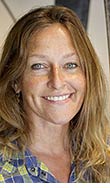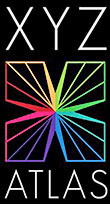Public helps create topographic maps of emotions on GIS Day
As part of Texas A&M University’s annual [Geographic Information System Day] (http://gisday.tamu.edu/) , the public helped artists, geographers and urban planners [map] (http://barasafa.wix.com/xyz-atlas-bcs#!participate/yjlag) some of the less tangible features of the Bryan/College Station landscape as they worked to create a geospatial record of the region’s emotional topography — a map showing where twin city denizens experience emotional highs and lows.
The project, orchestrated by Austin artist [Jennifer Chenoweth] (http://fisterrastudio.com/) with sponsorship from the Texas A&M College of Architecture [Diversity Council] (http://www.arch.tamu.edu/diversity/) , took place Nov. 18 on the East Quad of the College Station campus — the grass-covered area between the Langford Architecture Center and the Oceanography and Meteorology Building.
At the GIS Day event, which was featured in [The Eagle] (http://www.theeagle.com/news/local/aggies-texas-a-m-personnel-invited-to-explore-feelings-for/article_7ec2d8b8-07df-5a31-8176-9ef243e888af.html) , participants navigated a gigantic interactive map of the B/CS area painted in chalk on the lawn. They will be equipped with flags, color-coded to represent specific emotions, to plant in the areas on the map where those emotions were experienced.
Data gathered at this and future events will be compiled and added to data gathered [online] (http://barasafa.wix.com/xyz-atlas-bcs#!participate/yjlag) to create “The XYZ Atlas: The Experience Map of Bryan/College Station.” This creative mapping project and art installation, similar to Chenoweth’s previous undertaking, “ [The Hedonic Map of Austin] (https://vimeo.com/78756797) ,” is a crowd-sourced multimedia project that allows people to share stories and the locations where they had significant experiences. Once gathered, the data could provide a better understanding of the Bryan/College Station area by geospatially revealing how the cities are perceived.
“The XYZ Atlas records the influence the region has on its residents, and creates a community’s identity through a shared sense of place,” said Chenoweth. “It’s an interactive, public art piece consisting of people’s collective experiences.”
Those who couldn't make it to the more tactile, GIS Day event are encouraged to visit the project’s online B/CS [map] (http://barasafa.wix.com/xyz-atlas-bcs#!participate/yjlag) to plant virtual flags showing where around the towns their own best and worse experiences played out.
The final map will be revealed after Chenoweth and her team have gathered significant input from the project [website] (http://barasafa.wix.com/xyz-atlas-bcs#!participate/yjlag) and other public events to be scheduled throughout 2016.
The responses from the participants and XYZ coordinates will be used, she said, to create GIS maps, temporary art installations, unique 2-D and 3-D artworks and a digital platform.
Chenoweth’s art was recently showcased in “ You Are Here ,” a spring 2015 exhibit of her drawings, paintings and sculpture at the College of Architecture’s Wright Gallery. Her work examines the paths, plans, elevations, shapes and scale of various structures that create the built environment.
GIS Day, the annual worldwide salute to geospatial technology and its power to transform and enhance lives is always extra “spatial” in Aggieland, where it has been expanded to a three-day celebration, Nov. 16-18.
Simply put, GIS links locations (where things are) to information (what things are), allowing us to visualize, question, analyze and interpret data and better understand relationships, patterns and trends. GIS applications, virtually limitless, are increasingly requisite to science, industry and government and are quickly becoming indispensable in everyday life for everyday people.
Tags
- applied creativity
- archone gallery
- art
- building a better texas
- chud gallery
- coa gallery
- college culture
- diversity
- events
- exhibits
- fabrication
- landscape architecture & urban planning
- outreach
- partnerships
- rss
- urban systems
- visualization
- viz gallery
- wellness
- wright gallery
- wright gallery feed
Related Posts

Multiple artists’ drawings featured in fall Wright exhibit

Wright Gallery to exhibit eight artists’ work in 2016-17

Initiative fusing arts, technology education gains momentum

Wright Gallery 2014-15 lineup features seven noted artists

Domestic violence’s effects exhibited in Wright Gallery
Follow Us
Facebook Twitter Vimeo Youtube Flickr RSS
Recent Posts

Planning prof heads study of disaster housing aid

A message from the dean

Former student remembered as expert planner

Leading educator named new head of Architecture Dept.















_thumbnail_small.png)
